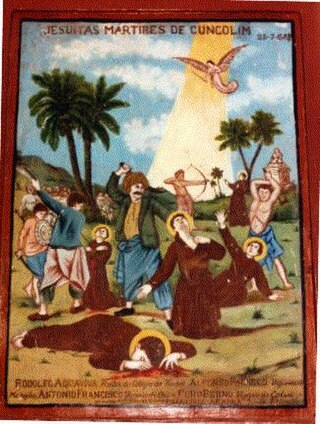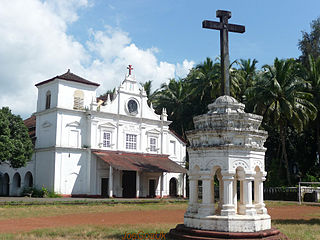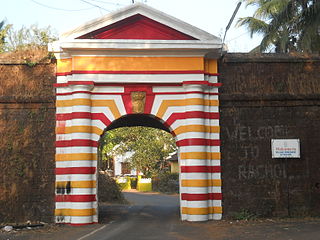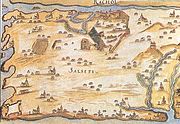
The history of Goa dates back to prehistoric times, though the present-day state of Goa was only established as recently as 1987. In spite of being India's smallest state by area, Goa's history is both long and diverse. It shares a lot of similarities with Indian history, especially with regard to colonial influences and a multi-cultural aesthetic.

Margao is the commercial capital of the Indian state of Goa. It stands on banks of the Sal river and is the administrative headquarters of Salcete sub-district and South Goa district. It is Goa's second largest city by population after Vasco.

Ribandar is a town in Tiswadi, Goa, located between the cities of Panjim and Old Goa.

Salcete is a subdivision of the district of South Goa, in the state of Goa, situated by the west coast of India. The Sal River and its backwaters dominate the landscape of Salcete. Historically, the sixty-six settlements south of the Zuari River formed the original Salcette territory. Salcete forms a part of the bigger Konkan region that stretches along the western shoreline of peninsular India.
Dom Diogo Rodrigues, Dom Diogo Roiz was a Portuguese explorer of the Indian Ocean who sailed as an ordinary helmsman under the command of Dom Pedro Mascarenhas around Goa. They sailed from the Cape of Good Hope eastward into little-known waters of the newly discovered route to Goa. Rodrigues island was named after him between 4 and 9 February 1528 because he had discovered it during his only return journey from Goa via Cochin to Lisbon, where he was elevated to the rank of a knight (cavaleiro) by John III of Portugal. He then returned to Goa and made a mark in the history of the Portuguese empire in the subcontinent around the mid-16th century.

Chorão, also known as Choddnnem or Chodan, is an island along the Mandovi River near Tiswadi, Goa, India. It is the largest among other 17 islands of Goa. It is located 5 kilometres away from the state capital, the city of Panaji and 10 kilometres away from the city of Mapusa.
Loutolim or LoutulimLottli pronounced:[lɔːʈlĩː], Portuguese: Loutulim) is a large village of South Goa district in the state of Goa, India. It is an important settlement in the Salcete sub-district.

Cortalim is a village in Morumugão, Goa, India. Its native Goan population is entirely Catholic and their main occupations include fishing and agriculture. Located on the banks of the Zuari River, it was previously known as Kushasthale.

The Cuncolim Massacre or Cuncolim Revolt was an incident that involved the massacre and mutilation of Christian priests and civilians by Hindu chieftains in the Portuguese Goa village of Cuncolim on Monday, 15 July 1583.

Assolna (Osollnnem) is a big village in the Salcete taluka of South Goa district, in the state of Goa, India. It is known for restaurants, ferry, the small traditional market, and local institutions. The Sal river flows through this village.
Chandor is a village in Salcete sub-district of South Goa, in the Indian state of Goa. It lies on the southern bank of the Zuari River and western bank of the Kushavati River.
Raia is a quaint village in the Salcete taluka of South Goa district, Goa state, India. It is located 4 km (2.5 mi) east from the district headquarters of Margao and 35 km (22 mi) from the state capital Panjim.

Anjediva Island is an Indian island in the Arabian Sea. It sits off the coast of Canacona, Goa. It is politically part of Goa state, geographically the nearest mainland is the coast of the Canara subregion of Karnataka state.

The Rachol Seminary, also known today as Patriarchal Seminary of Rachol, is the diocesan major seminary of the Primatial Catholic Archdiocese of Goa and Daman in Rachol, Goa, India.

The Igreja de Nossa Senhora das Neves is a historical Catholic church in Rachol village, Salcete sub-district, on the southern banks of the Zuari river, in the South Goa district of Goa state, India. The church was built in the 1560's during the Goa Inquisition. It is situated in close proximity to the renowned Rachol Seminary. There is a church of the same name in the neighbouring village of Raia.

Shri Damodar Temple Zambaulim or Shri Damodara Sansthaan is a Hindu temple on the bank of the Kushawati River near the village of Zambaulim 22 km from the city of Margao on the border of Quepem region in the south of Goa. The temple houses a celebrated murti, or image, of Lord Shiva incarnated as Lord Damodar.

The Rachol Fort is a historical Portuguese era fort located in the village of Rachol, Salcette concelho, in the state of Goa on the west coast of India.

Real Colégio de Educação de Chorão is a defunct Catholic seminary that was founded on 2 April 1761 in Chorão, India. It belonged to the Parish of Our Lady of Grace Church.
























